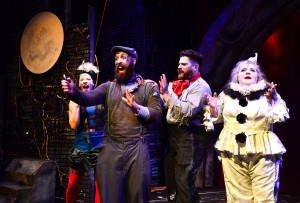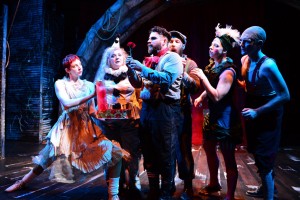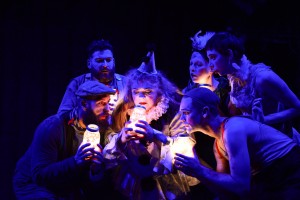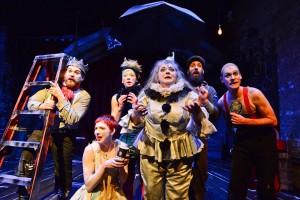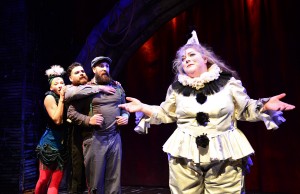THE HOTTEST SHOW IN TOWN
One of the best-reviewed and most popular Christmastime shows, The Ruffians’ Burning Bluebeard, returns beginning tonight for three weeks only through Jan. 4, 2015, at Theater Wit. Pam Chermansky joins original cast members Anthony Courser, Molly Plunk, Jay Torrence, Leah Urzendowski Courser, and Ryan Walters to tell this fantastical tale inspired by Chicago’s 1903 Iroquois Theatre fire. Directed by Halena Kays, this remount coincides with the 111th anniversary of the Dec. 30 infamous event; along with the regular run, special performances at 3 pm (the actual time of the fire) and 8 pm will be given on Tuesday, December 30. Below is Stage and Cinema’s review from last year’s show with this year’s photos. Don’t miss this limited run.
* * * * * * * * * *
Having moved from Andersonville to Lakeview, the best production of last year is back to rival any currently playing: No longer sprawling the width of the Neo Futurarium’s stretched-out stage, The Ruffians’ superb, 100-minute Burning Bluebeard is concentrated in Theater Wit’s proscenium space. Its glorious, dream-like make-believe and contagious magic realism feel even more intimate and intense. It remains the hottest show in town.
As before, it’s a bracing, bittersweet offering for the holiday season. It’s equally a tribute to the purest impulses of theater (“We just want to make you happy!”) and to the horror of unintended consequences. Reimagined from the inside out, its tragedy erupted during a merry Yule season 110 years ago (Death takes no holidays). Alternately comical and compassionate, Jay Torrence’s evocation of the Iroquois Theatre holocaust of 1903 captures a rapturous empathy with performers past and present: Here the innocence of entertainment clashes with the facts of a fire. Moving in every way, driven, inventive and blessed with perfect pitch, Halena Kays’ reprise staging rekindles a Christmas nightmare that’s impossible to exorcise.
Like the “unsinkable” Titanic, the “fireproof” Iroquois Theatre was brand new–a $6 million Loop playhouse enjoying its maiden season as it competed with Victor Herbert’s much finer Babes in Toyland. The terror on December 30th took only 15 minutes: An explosion from a moonbeam lighting effect triggered a blaze that, fed by embers and backdrafts, spread across the muslin scenery, consumed a perversely combustible fire curtain, was fanned by the backstage door from which all but one of the 400+ performers escaped alive, and burst into a fireball, turning the upper balconies into a Viking funeral. The rampaging flames and towering smoke incinerated or choked 605 theatergoers (mostly women and children) of the standing-room-only, 1600-seat new theater at Randolph and State (where the Oriental Theatre now stands). We own this conflagration.
The show’s opening implies that, yes, the show does go on: The lost words of this unintended horror show have somehow soaked into the stage (Dan Broberg’s fire-ravaged broken proscenium and props, eerily lit by old-fashioned filament bulbs). Torrence imagines a Pirandello-like situation in which five clowns (emerging, ghost-like, from body bags on the stage) who experienced the disaster are forced (as Coleridge did his ancient mariner) to retell the tragedy until they can provide the happy ending that their now-dead audience had every right to enjoy.
These heartbroken zanies must complete the silly Christmas pantomime “Mr. Bluebeard” whose second act became a Chicago hell rivaled only by the bigger one of 1871 or the Our Lady of Angels school fire 53 years later. Poorly reviewed and, until that day, badly attended because of the weather, a recession, and a transit strike, the panto (hardly family fare if you consider its content) depicted the chamber of horrors where Bluebeard impaled his wives. (It was one of 260 set pieces in the mammoth extravaganza.) The matinee ended for all by 4 p.m. (with all the watches frozen at 3:50), just as, accompanied by their cavaliers, the six wives of the spouse-killing title king with his murder room and bloody key strolled out to sing the ballad “Under the Moonlight.” Who knew that a special effect could conceal the Angel of Death?
 Haunted by guilt over the loss of so many other innocents, Torrence’s troupe is doomed to move beyond that second-act firestorm and prove that art can improve on life—and transcend death.
Haunted by guilt over the loss of so many other innocents, Torrence’s troupe is doomed to move beyond that second-act firestorm and prove that art can improve on life—and transcend death.
The acrobatic and supple cast plays Iroquois Theatre survivors, ranging from the headliner and Chicago favorite Eddy Foy to a literally death-defying aerialist (the one performer to die in the blaze), overwhelmed stage crewman, clueless Fairy Queen, sardonic clown artist, or appalled audience members. Handing out gift boxes to audience members (which will be opened to present keys to the “Bluebeard” scenes they reenact), the cast absorbs the audience into the action, with one playing the unluckiest little boy in Chicago (who turns out to be the luckiest as well).
Notwithstanding its non-negotiable disaster, this perverse “panto” with its gallows humor can be screamingly funny: To a rollicking rap rhythm and employing a complex blackboard drawing, they point out all the perilous escape routes from the doomed downtown venue to the protection of Randolph Street. (The incendiary Iroquois Theatre gave a whole new meaning to exit strategy.) Everything that could go wrong did, including fire doors that sadistically opened inward, exits blocked by curtains, flammable material everywhere.
Their recreation of the first act includes restoring an elaborate ballet sequence that, although it made no sense in a plot that made even less), constituted one more spectacle to delight the entranced, doomed crowd. As the fake moonlight sparks real flames, once again Eddie Foy tells the children to stay in their seats—the worst possible advice he could have offered. Again concealed exits create stacks of burned bodies. As stage smoke pours in and the lights flash red, the actors perform a seated danse macabre: Then total darkness: We hear an unbearable, minute-long sound recreation of the firestorm, screaming kids, and deafening panic. The inferno could not be more completely recreated.
But Burning Bluebeard pushes beyond its title: The sextet is granted a happy rather than hideous ending, with the serial killer Bluebeard properly disposed of (as the children on December 30, 1903 never got to see). For one more night The Ruffians’ art has triumphed over the Iroquois Theatre’s senseless slaughter. The purgation works: In perhaps their finest offering ever, The Ruffians deliver a Christmas present for all Chicagoans.
photos by Evan Hanover
Burning Bluebeard
The Ruffians
Theater Wit, 1229 W Belmont
scheduled to end on January 4, 2015
for tickets, call (773) 975-8150 or visit www.TheaterWit.org
for info on more Chicago Theater, visit www.TheatreinChicago.com

